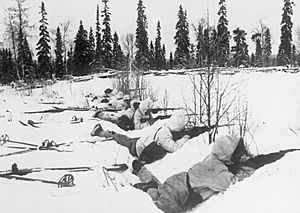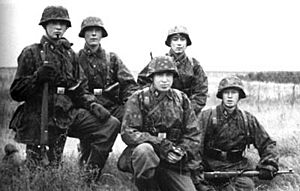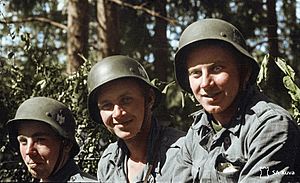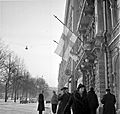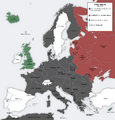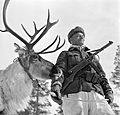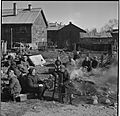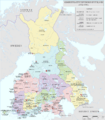Continuation War facts for kids
The Continuation War was a war between Finland and the Soviet Union. It lasted from June 26, 1941, to September 19, 1944. It's called the Continuation War because Finns saw it as a follow-up to the Winter War. They also felt threatened by the Soviet Union during the peace that came after the Winter War.
Finland's main goal during World War II was to stay an independent country. They wanted to manage their own affairs in a difficult political world. Finland did achieve this goal, but it came at a high cost. Many people died, they lost land, paid money, and had to change how they acted towards the Soviet Union.
The war officially ended with the Paris peace treaty in 1947.
Contents
Why the War Started
After the Winter War ended, Finland wanted to get back at the Soviet Union. Many people hoped to get back their homes in Karelia. About 10% of Finland's population had been forced to leave Karelia quickly after the Winter War peace. They hoped this unfair situation would be fixed after World War II.
Some people also wanted to protect other Finnic groups living under Soviet rule. They thought Finland should expand its territory to the east. These people believed Finland's old way of focusing on Scandinavia (especially Sweden), the League of Nations, and other democratic Western countries had failed.
After the Winter War, Finland quickly started to get close to Nazi Germany. This was surprising because Germany had been an ally of the Soviet Union during the Winter War. Finland got a new government that was more friendly to the Nazis. From August 18, 1940, Finland secretly talked with Germany about working together militarily. They bought much-needed weapons from Germany. Before this, it was impossible because of the Molotov-Ribbentrop Pact between Germany and the Soviet Union. In return, Finland helped Germany move troops to Finnmark in Northern Norway. Finland hoped that having German troops nearby would stop the Soviet Union from attacking again. They thought it would make Germany join Finland's side.
This secret agreement between Finland and Germany went against the peace treaty of the Winter War. It was mainly meant to stop cooperation between Germany and Finland.
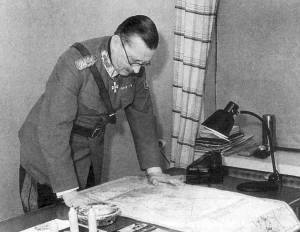
Before the Winter War, Adolf Hitler wasn't very interested in Finland. But now, he saw Finland as a good place to prepare for his upcoming invasion of the Soviet Union. He also saw the value of the Finnish army. The secret agreement from August 1940 became official in September. It allowed Germany to send troops through Finland. This was supposedly to help Germany send more soldiers to northern Norway.
Another agreement in December 1940 led to German troops being stationed in Finland. They were mostly near the northern border with the Soviet Union. More and more German soldiers arrived in the following months. They set up camps and supply bases along the road to Norway. These places were later used to gather troops for an attack on Northern Russia. Even though most Finns didn't know all the details of the agreements with Germany, they generally approved of the pro-German policy. People from Karelia especially wanted to get back their lost lands.
Working with Germany
By the spring of 1941, the Finnish military knew about Germany's plans to invade Russia. But no one was completely sure what Hitler would do. There was still a question of whether Hitler would really attack the Soviet Union before defeating Great Britain. Maybe the troop build-up was just to put pressure on the Soviets. If so, Finland worried they might be used as a bargaining chip between Hitler and Stalin.
In 1941, the German army was at its strongest. It seemed like Germany would win the war and control Europe. There were concerns about how the Nazis viewed different races: Nazi thinkers didn't see Finns in a good light. However, by actively helping Germany, Finland hoped to have a more independent position in Europe after the war. They also hoped to get rid of the Soviet threat for good. And they thought they could include other Finnic peoples in Finland. This idea became more popular among Finnish leaders and in the news as Germany and the Soviet Union prepared for war.
What started as a defensive plan for Finland, meant to balance Soviet pressure with German help, turned into an offensive plan. Finland aimed to invade the Soviet Union. Finns were tempted by the chance to get back their lost lands and end the Soviet threat.
War Breaks Out
Signs and rumors of Germany's attack on Russia grew stronger. On June 9, partial mobilization was ordered. About 30,000 Finnish air defense troops in the north were placed under German command. Germany already controlled the northern half of the border with Russia. On June 14, the 3rd Army Corps was also mobilized and put under German command. On June 17, a general mobilization took place. On June 20, Finland's government ordered 45,000 people near the Soviet border to leave their homes. Finally, on June 21, Germany officially told Finland's General Staff chief, General Erik Heinrichs, that the German attack had begun.
The Finnish government didn't want to seem like the attacker. So, Finland did not join Germany's invasion of the Soviet Union on June 22. (Hitler's public statement gave a different impression. He said Germany was attacking the Bolshevists "in the North, in alliance with the Finnish freedom heroes.") Three days later, Soviet planes bombed Finland. Towns like Porvoo, Turku, and Helsinki were hit, with some wooden homes catching fire. This gave the Finnish government the reason it needed to start fighting. War was declared on June 26.
On July 10, 1941, the Finnish army started a big attack on the Karelian Isthmus and north of Lake Ladoga. Field Marshal Mannerheim's order of the day clearly showed that Finland's involvement was an attack. By the end of August 1941, Finnish troops had reached the borders they had before the war. Going beyond these old borders caused disagreements among the soldiers, in the government, and among the public. While some people supported expanding Finland's territory, it was not a unanimous decision.
This also caused problems with other countries, especially Sweden and Britain. In May and June, Finland's Foreign Minister Witting had told them confidentially that Finland had no plans to work with Germany on a military campaign. He said Finland's preparations were purely defensive. Sweden's leaders had hoped to improve relations with Germany by indirectly supporting Finland. However, political support in Sweden wasn't enough, especially after Mannerheim's famous order and after Finland started a war of conquest. A clear result was that Finland now depended on Germany for food, ammunition, and weapons.
By December 1941, the Finnish advance had reached the edges of Leningrad and the Svir River. This river connects the southern ends of Lake Ladoga and Lake Onega. By the end of 1941, the front lines became stable. The Finns did not launch any major attacks for the next two and a half years.
Talking for Peace
Germany's plan for its eastern campaign was a quick war, a "blitzkrieg," meant to last only a few weeks. British and US observers also thought the attack would be over before August. But in the autumn of 1941, it became clear they were wrong. Leading Finnish military officers began to doubt Germany's strength. Finland's strategy changed. They offered to make a separate peace with the Soviet Union. But Germany was too powerful and scary. Finland had to continue the war for some time. They tried to keep their own forces as safe as possible, hoping that the German army (Wehrmacht) and the Soviet army (Red Army) would weaken each other.
Finland's part in the war greatly helped Germany. The Soviet fleet was trapped in the Gulf of Finland. This freed up the Baltic Sea for German submarine training and for German ships. This was important for getting vital iron ore from northern Sweden and nickel from the Petsamo area. Finland's sixteen divisions kept many Soviet troops busy. They put pressure on Leningrad (even though Mannerheim refused to attack it directly) and threatened the Murmansk Railroad. Sweden became more isolated and faced increasing pressure to agree to Finnish and German wishes, though this had limited success.
Even with Finland's help to Germany, the Western Allies (like Britain and the US) had mixed feelings. They felt some goodwill towards Finland but also needed to support their important ally, the Soviet Union. Because of this, Britain declared war on Finland, but the United States did not. There was no fighting between these countries and Finland. However, Finnish sailors were held in other countries. In the United States, Finland was highly respected. This was because Finland had faithfully paid back its World War I debt throughout the years between the wars. Finland also earned respect in the West later for its strong democracy. They also refused to allow Nazi anti-Jewish practices in Finland. Finnish Jews served in the Finnish army. Jews were not only accepted in Finland, but most Jewish refugees were also given a safe place to stay.
The War Ends
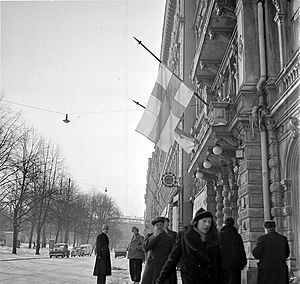
Finland started looking for a way out of the war after Germany's terrible defeat at Stalingrad in January-February 1943. Edwin Linkomies formed a new government with making peace as its main goal. Talks happened on and off between Finland (represented by Juho Kusti Paasikivi) and the Western Allies and the Soviet Union from 1943 to 1944. But they couldn't reach an agreement.
Instead, in June 1944, the Soviet Union launched a huge attack against Finnish positions on the Karelian Isthmus and in the Lake Ladoga area. On the second day of the attack, Soviet forces broke through the Finnish lines. In the days that followed, they advanced so much that it seemed Finland might not survive. Finland clearly needed more weapons and ammunition. The Nazi Foreign Minister Joachim von Ribbentrop offered these supplies. In return, he wanted Finland to promise not to seek a separate peace again. President Risto Ryti gave his promise. Ryti intended for this promise to last only for the rest of his time as president.
With new supplies from Germany, the Finns were able to handle the crisis. They stopped the Russians in early July 1944. The Finns had retreated about one hundred kilometers, bringing them back to roughly the 1940 borders. Finland had already become less important to the Soviet leaders, who now focused on Poland and the Balkans. Even though the Finnish front was stable again, the Finns were tired and wanted to get out of the war. President Risto Ryti resigned. Finland's military leader and national hero, Carl Gustaf Mannerheim, became president. He took on the responsibility of ending the war.
On September 19, 1944, a ceasefire (which was almost a preliminary peace treaty) was signed in Moscow between the Soviet Union and Finland. Finland had to agree to many difficult terms. The Soviet Union got back the borders from 1940, plus the Petsamo area. The Porkkala Peninsula (near Finland's capital Helsinki) was leased to the Soviet Union for fifty years, and they were given transit rights. Finland's army had to quickly become smaller. And Finland was required to make all German troops leave its territory. Since the Germans refused to leave Finland on their own, the Finns were forced to fight their former allies in the Lapland war.
Finland didn't win the war. It would have been impossible against a nation nearly 100 times its size. But Finland did manage to avoid being completely occupied and likely destroyed. A major goal for Finland's foreign policy after the war was to keep it that way.
Images for kids
-
Finnish flags at half-mast in Helsinki on 13 March 1940 after the Moscow Peace Treaty became public
-
Vasilievsky Island in Saint Petersburg, pictured in 2017. During the Winter and Continuation Wars, Leningrad, as it was then known, was very important to both sides.
-
Joachim von Ribbentrop (right) saying goodbye to Vyacheslav Molotov in Berlin on 14 November 1940 after talking about Finland's future.
-
President Risto Ryti giving his famous radio speech about the Continuation War on June 26, 1941.
-
A Finnish soldier with a reindeer in Lapland. Reindeer helped by pulling supply sleighs in snowy conditions.
-
Wilhelm Keitel (left), Hitler, Mannerheim and Ryti meeting at Immola Airfield on 4 June 1942. Hitler made a surprise visit for Mannerheim's 75th birthday and to talk about plans.
See also
 In Spanish: Guerra de Continuación para niños
In Spanish: Guerra de Continuación para niños


